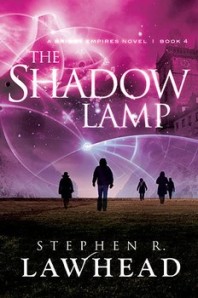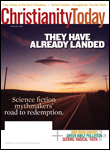 And so, with the turn of the final page of The Fatal Tree, the Bright Empires series, the five-book epic Christian science fantasy by Stephen Lawhead, has come to an end. It’s hard for me to put into words the last installment of such an ambitious project. Part of me wants to give a series review, but I’m inadequate to do so since I read the five books as they released. What details have I forgotten?
And so, with the turn of the final page of The Fatal Tree, the Bright Empires series, the five-book epic Christian science fantasy by Stephen Lawhead, has come to an end. It’s hard for me to put into words the last installment of such an ambitious project. Part of me wants to give a series review, but I’m inadequate to do so since I read the five books as they released. What details have I forgotten?
And yet, merely reviewing The Fatal Tree feels inadequate. I wouldn’t expect anyone to start with this book, so a review of it as if it were a stand alone seems disingenuous. I think the best way to approach this daunting assignment is for me to give my random thoughts . . . randomly, as opposed to writing a formal review.
With that decided, here goes.
The Fatal Tree continues the story where The Shadow Lamp left off. The ley travelers suspect something serious has happened in the omniverse to upset the way things work. In fact, they believe that in all probability, an anomaly has taken place which has caused the omniverse to slow, leading ultimately to contraction, or the complete destruction of everything.
The main character, Kit, thinks he knows what this anomaly is—an event he witnessed at the Spirit Well. The problem is that a giant yew tree is growing over the place that would give him and his fellow questers access to the Well. Their job is to find a way to the Well and reverse the event in hope that they will also reverse contraction. The yew tree, however, emits huge amounts of energy, enough to kill anyone who touches it.
Some bloggers have mentioned that the quest for the Spirit Well is a shift from the original series quest—to find the Skin Map. The shift took place in book three, however, so from my perspective it would be odd to once again take up the search for the Skin Map. In The Spirit Well the focus becomes the object to which the map led and not the map itself. That Kit found the Well, saw it, and believes he can lead others to it, is a game changer. But problems of one kind or another continue to block him and the others.
Some bloggers also felt as if the high stakes didn’t ring true. I’d have to agree with this thought. The fact that I’m reading a book about the possibility of the end of everything obviously means (were it true and not fiction—a sensation novelists try to create) that the questers were successful which reduces the tension of the story.
Some CSFF tour participants felt the characters weren’t particularly deep or developed. I didn’t think so. Rather, I thought some of the minor characters like Lady Fayth made great changes; others showed their true colors more clearly; several relationships were furthered; but most importantly, an unlikely character changed and an unlikely character took heroic action.
I have to think that Mr. Lawhead’s use of the omniscient point of view may have been the reason some readers didn’t feel the story showed great character development. Without a doubt, it is a writing technique that doesn’t bring readers as close as first person or even close third person.
I was probably more aware of the omniscient voice in The Fatal Tree than I had been in the previous books. With this book wrapping up the many strands of an epic tale, omniscient voice may have been the only way to move from one set of characters in various locations and times to another. Perhaps all the movement drew more attention to the voice, however.
I did wonder from time to time if all the characters and all the movement were necessary. For instance, a good amount of time was spent on one character looking for another. When at last the connection was made, nothing came of it—that is, the encounter ended quickly and badly, and the questers were no closer to finding a way to the Spirit Well.
Along that line, there seemed to be a couple threads for which I saw no purpose. For example, at one point Mina, in trying to reach a certain spot by traveling along the ever less-stable ley lines, landed in a blizzard—with the Burly men’s wild cat. The animal ends up running off, dragging its chain, and nothing is heard about it again. At the same time, Mina sees a pool that doesn’t freeze over, though everything else is ice and snow. She steps into it and is transported to a different place and time.
A pool, I think. And they are looking for the Spirit Well. Might this be connected? A prehistoric version of what they’re looking for? Or a form of it before the yew tree grew? We never visited that pool again, and it didn’t have any apparent connection with the over all quest.
Another subplot had to do with one of Arthur Flinders-Petrie’s descendants, Douglas. He had stolen a book which was supposed to be important in the quest for the Skin Map. The book never factors into the resolution and Douglas has little to do with the main plot line.
In the same way the secret ley travelers organization, the Zetetic Society, which seemed so important in The Shadow Lamp, fades in importance in The Fatal Tree, receiving only a mention from time to time.
All this to say, I liked this final book of the series better for paring down the cast to the most significant characters. And still there was, what felt like to me, an utterly useless thread with Tony Carter and the scientists back in the US who were trying to corroborate that the omniverse was indeed about to contract. These scenes felt by and large, superfluous to me though I understand some found them of great interest and thought they gave the book a greater science fiction feel.
Well, yes, probably. Since I’m not a big science fiction reader, you can see why I felt those sections could have been left out!
I could go on. There’s so much to say about this book, and I haven’t touched upon the key theme—in fact, I don’t recall any of the tour participants discussing this theme either, which is a little disturbing.
Here’s the end before the Epilogue and the author essay in which this theme comes forward again:
“It looks like we’re just in time,” observed Cass, tapping the pewter carapace [of the Shadow Lamp].
“You know there’s no such thing as coincidence,” Kit replied lightly. “Right?”
“Yeah, right,” said Cass. “Let’s go home.”
No such thing as coincidence is a repeated phrase in this book, and it’s not by coincidence! 😉
This book also contained the greatest spiritual content of the five, and yet it left me wondering. What I had taken in earlier books to be symbols of new birth or of redemption were not. What they were, I’d like to think about some more. And I’d like to understand better what actually happened in the climax. I’ll be re-reading that chapter, most certainly.
All in all, I highly recommend the Bright Empires series to readers who love epic stories and appreciate the writing style made possible by the omniscient voice—Mr. Lawhead has full command of the language and is able to provide rich description of the varied places and eras about which he writes. This series is a unique blend of speculative and historical fiction. Readers who enjoy either genre or both will be swept up in the expansive tale.
In conjunction with the CSFF Blog Tour, I received a gratis copy of The Fatal Tree so that I could write my thoughts about the book in this post.

 I was sort of saving my review of
I was sort of saving my review of  What is it about Alaska? Seems like more and more Christian novelists are from Alaska —
What is it about Alaska? Seems like more and more Christian novelists are from Alaska —  As far as Jill’s writing is concerned, she’s represented by Amanda Luedeke of the
As far as Jill’s writing is concerned, she’s represented by Amanda Luedeke of the 


 Thanks to an email group I’m a member of, I found an incredible article in Christianity Today entitled
Thanks to an email group I’m a member of, I found an incredible article in Christianity Today entitled 
![PowerElementsCharacterDevelopment[1000][1]](https://rebeccaluellamiller.files.wordpress.com/2015/05/powerelementscharacterdevelopment10001.jpg?w=205)







